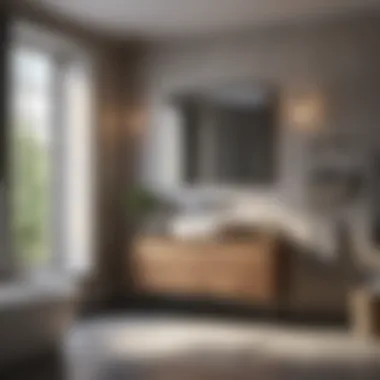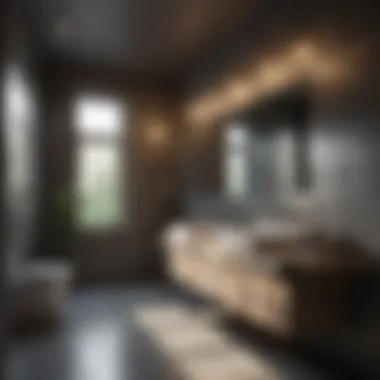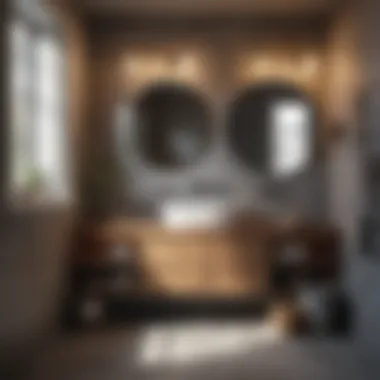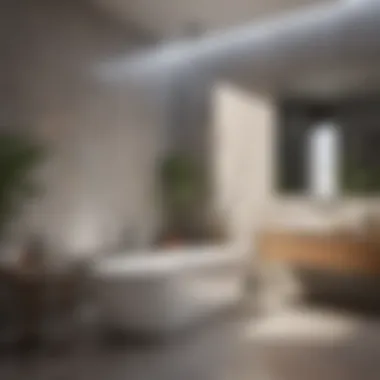Affordable Innovations for a Stylish Bathroom


Intro
Redefining a bathroom space can be a complex task. Budget restrictions add an additional layer of difficulty. Nonetheless, it is possible to achieve a stylish and functional bathroom without costly renovations. This section will explore practical strategies, cost-effective materials, and DIY solutions that meet the objectives of design and affordability. By considering your preferences and applying informed choices, you can turn your outdated bathroom into a refreshing retreat.
Design Inspirations
Trending Styles
To begin, it is crucial to understand current design trends. Minimalist aesthetics are gaining popularity, focusing on simplicity and functionality. This style emphasizes clean lines and subtle touches, ensuring a spacious feel. Additionally, integrating sustainable elements into your design can reflect environmental consciousness, making bamboo or recycled materials popular choices.
Another emerging trend involves vintage and retro designs. Utilizing classic pieces can lend a timeless quality to your space. Vintage tiles or fixtures can merge well with modern updates, striking a balance between old and new.
Color Palettes
Color selection plays a vital role in bathroom design. Light tones such as pale blues, soft greens, and whites help create an illusion of a larger space. These colors invoke calmness and relaxation, essential for a personal sanctuary.
Alternatively, bolder choices can bring energy to the room. Deep navy or forest green can create a dramatic effect when paired with crisp whites or earthy accents. Mixing textures and patterns within these colors can add depth without overwhelming the senses.
"A well-chosen color palette can transform an ordinary bathroom into a stunning space with ease."
Product Recommendations
Bath Accessories
Investing in the right bath accessories can enhance practicality and style without overwhelming the budget. Consider the following options:
- Shower curtains: Choose patterns or colors that fit your overall theme.
- Bath mats: Opt for plush and absorbent materials to ensure comfort and safety.
- Towel racks: Not only functional but serve as a design element. Wall-mounted racks free up floor space.
Explore local stores or online platforms like Amazon for affordable finds.
Bathroom Essentials
When it comes to essential items, several products can enhance functionality:
- Vanities: Look for stylish yet inexpensive models from IKEA or Wayfair.
- Lighting: Consider LED options that save energy and brighten the space effectively.
- Storage solutions: Utilize shelving or cabinets to keep clutter at bay, maintaining a clean look.
Each aspect contributes to the overall design, making a more organized and inviting bathroom.
Understanding the Basics of a Cheap Bathroom Renovation
Embarking on a bathroom renovation can be an overwhelming experience, especially when financial constraints are present. It is vital to grasp the fundamentals of a budget-friendly renovation. Understanding these basics helps in making informed decisions that enhance the bathroom's functionality while minimizing costs. This section lays the groundwork for effective renovation strategies that adhere to a budget.
Defining 'Cheap' in Bathroom Renovation
Defining what 'cheap' means in the context of bathroom renovations is essential. Cheap does not equate to low-quality or substandard work. Rather, it signifies value for money. A cheaply renovated bathroom should still offer good aesthetics and durability. This approach involves choosing affordable materials, sourcing budget-friendly fixtures, and opting for practical design choices. Focusing on creativity and innovation can lead to impressive results without emptying your wallet.
The Importance of a Realistic Budget
A realistic budget is the backbone of any successful renovation. Setting a budget not only helps in keeping track of expenses but also aids in prioritizing essential features. Begin by detailing all expected costs, including materials, fixtures, labor, and unforeseen expenses. Allocating a portion of the budget for unexpected costs is wise since they often arise during renovations. A well-structured budget can help maintain focus and keep expenditures in check throughout the process.
Common Misconceptions about Cheap Renovations
Several misconceptions exist about cheap renovations that can lead to poor decisions. One common belief is that lower costs mean compromising on quality. However, smart planning and innovative material choices can offer both affordability and quality. For example, opting for vinyl instead of expensive ceramic tiles can be financially advantageous without sacrificing style. Another misconception is that doing everything DIY is always cheaper. While some projects may benefit from a DIY approach, professional help may be necessary for certain aspects. Thus, understanding these misconceptions can lead to more informed and effective planning.
Strategic Planning for Budget-Friendly Projects
Effective strategic planning is key when designing a budget-friendly bathroom. It allows homeowners to allocate funds wisely, ensuring that each dollar spent contributes meaningfully to the renovation's intent and aesthetics. This section will outline several important considerations that guide the planning phase of your bathroom project, offering a path to a successful and economical transformation.
Assessing Your Current Bathroom Conditions
Before embarking on a bathroom redesign, it is crucial to take a thorough inventory of your current space. This means looking at the existing layout, condition of fixtures, and overall appearance.
- Evaluate Fixtures: Check what can be retained, such as bathtubs, toilets, or sinks. If these are still in good working order, it can save you considerable money.
- Plumbing and Electrical Systems: Assess if there are any issues with plumbing or electrical systems. Fixing major problems can be expensive, but neglecting them can lead to larger costs later.
- Layout Considerations: Sometimes, keeping the layout the same can save on costs. Assess whether moving walls or plumbing can be avoided.
Identifying the strengths and weaknesses of your existing bathroom sets a clear pathway for improvements and helps limit spending where necessary.


Establishing Priorities: What to Keep and What to Change
Not all components of a bathroom need to be changed, and understanding priorities can make your project budget-friendly. Focus on aspects that impact functionality and aesthetics the most.
- List Necessary Changes: Write down what needs immediate attention, such as leaky faucets or outdated lighting.
- Aesthetic Enhancements: Make decisions about paint, hardware, and decor. Simple changes can uplift the entire space without the need for drastic renovations.
- Cost vs. Value: Evaluate which changes provide the best return on investment. For instance, investing in energy-efficient fixtures not only saves money in the long term but also enhances the bathroom’s appeal.
By distinguishing between must-haves and nice-to-haves, you can efficiently allocate your budget and avoid unnecessary expenditures.
Creating a Comprehensive Design Plan
A well-thought-out design plan is fundamental for any renovation project. It serves as the roadmap that guides each decision and detail.
- Sketch Your Design: Start with a rough layout that includes placements of major fixtures such as sinks and toilets.
- Research Materials & Products: Look for affordable options for materials and fixtures. Make a list of products that align with your budget and desired aesthetic.
- Visualize the Space: Use software or apps that allow you to create a mock-up of your designed space. This can help you visualize the final outcome and make adjustments beforehand.
Designing with clarity and precision can prevent costly mistakes, ensuring that your bathroom reflects your personal style while remaining within financial limits.
A successful renovation begins with a strong strategy that aligns your vision with practical implementation.
Cost-Effective Design Choices and Materials
When designing a bathroom on a budget, cost-effective design choices and materials play a critical role. They allow homeowners to achieve desired aesthetics and functionality without overspending. It is essential to understand how various elements like fixtures, flooring, and wall treatments can enhance the overall look while being easy on the wallet.
Selecting Budget-Friendly Fixtures
Faucets and Sinks
Faucets and sinks are pivotal elements in any bathroom. Choosing affordable yet stylish fixtures can dramatically affect the overall feel of the space. Look for options that boast durability and water efficiency, which can help save on utility bills.
One popular choice is the single-handle faucet. Its ease of use and modern appearance make it a beneficial selection for those looking to upgrade without spending too much. Moreover, many budget-friendly sinks come in various styles, from pedestal to undermount, allowing for a diverse range of designs. However, be cautious of plastic sinks as they may not stand the test of time compared to ceramic or stainless steel options.
Showerheads and Toilets
Focusing on showerheads and toilets can lead to significant savings. Water-saving showerheads, for instance, can reduce water consumption without sacrificing pressure. Brands like Delta and Moen offer various affordable models that are both functional and stylish.
Toilets are another area where smart choices matter. Low-flow models can greatly decrease water usage, impacting both the environment and monthly water bills positively. Select toilets with eco-friendly certifications for assurance in quality and performance. Yet, price can be a factor here, as professional installation of more complex models might incur additional costs.
Lighting Options
Lighting is a transformative design choice that can change the atmosphere of a bathroom. Opting for LED lighting not only saves energy but also allows various styles—from contemporary to vintage.
Vanity lighting fixtures, such as sconces and flush mount lights, can provide adequate illumination while adding elegance. The unique feature of dimmable options allows users to adjust brightness according to mood or task. However, it's important to ensure that the fixtures are compatible with bathroom conditions to avoid moisture-related damage.
Understanding Affordable Flooring Options
Vinyl Flooring
Vinyl flooring is one of the most accessible options for budget-conscious homeowners. Its resilience and water resistance make it an ideal choice for bathrooms. Available in a wide range of designs, vinyl can mimic the appearance of more expensive materials like wood or stone.
This versatility is a primary reason for its widespread use. It is also cost-effective and easy to install. Keep in mind that some cheaper varieties may wear out faster, leading to potential replacement costs.
Laminate Flooring
Laminate flooring offers a budget-friendly alternative that provides the look of hardwood. It is durable and can withstand moisture better than traditional wood.
The key characteristic here is its ease of maintenance, as it only needs regular cleaning to keep it looking good. However, not all laminate is suitable for bathrooms; ensure the selected product is water-resistant.
Ceramic Tiles
Ceramic tiles are a versatile choice for bathroom flooring. They are not only affordable but also come in numerous designs, sizes, and colors. Their durability and resistance to water make them a wise investment in the long run.
While ceramic tiles might require a more labor-intensive installation, they offer longevity and low maintenance, benefiting homeowners in the future. Consider using larger tiles to minimize grout lines, which can help lower cleaning time.
Wall Treatments on a Budget
Painting vs. Wallpaper


When it comes to enhancing wall aesthetics without exhausting the budget, painting often comes out on top. It is relatively inexpensive and allows for personalization. Picture framing or stenciling techniques can also add character.
Wallpaper is another option, featuring trendy designs at reasonable prices. However, its application can be tricky and may require professional help to avoid peeling or misalignment. For simple updates, consider peel-and-stick options as an easy and temporary solution.
Affordable Backsplashes
Installing an affordable backsplash can provide a significant visual impact. Options like adhesive tiles or vinyl decals can dramatically change the atmosphere. They come in various designs that can match almost any theme.
The unique aspect of these backsplashes is their easy installation. However, ensure they are suitable for high-moisture areas to avoid issues down the line.
Alternative Wall Panels
Alternative wall panels can be a creative solution for those on a budget. Products like beadboard or faux wood panels offer a classic look at a reduced cost.
They are typically easy to install and can be painted to fit the desired color scheme. Just make sure to use moisture-resistant materials in the bathroom to prevent damage from humidity.
In summary, affordable innovations in bathroom design hinge on careful selection of materials and fixtures that align with both budget and personal taste. By prioritizing durability and maintenance in choices, homeowners can achieve an attractive bathroom without overspending.
Effective DIY Solutions for Your Bathroom
Incorporating effective DIY solutions can greatly enhance a bathroom renovation, especially when working within budget constraints. These projects not only provide a cost-effective method to achieve desired outcomes, but they also foster a sense of ownership and satisfaction. Many homeowners find it rewarding to take an active role in transforming their space. Moreover, DIY initiatives can be customized to meet personal preferences, ensuring that the redesigned bathroom reflects the owner's unique style. This section explores various DIY projects that are both achievable and impactful, providing practical advice and considerations.
Incorporating Simple DIY Projects
Built-In Shelves
Built-in shelves are an excellent addition to any bathroom renovation project. They provide practical storage solutions without occupying too much space. One key characteristic of built-in shelves is their ability to blend seamlessly with the existing decor. This makes them a popular choice for many homeowners. Built-in shelves can be constructed from various materials, which allows for customization according to budget and style.
The unique feature of built-in shelves is their versatility. They can be used to store towels, toiletries, or decorative items, enhancing both functionality and aesthetics. However, one potential disadvantage is the initial effort required for proper installation, especially if careful measurements and sturdy supports are not utilized.
Vanity Upgrades
Upgrading the bathroom vanity is another impactful DIY project that significantly contributes to aesthetics and functionality. A key characteristic of vanity upgrades is the ability to improve storage capacity and achieve a more modern look. Many homeowners opt for budget-friendly options, such as refinishing or painting existing vanities, which can completely change the appearance of the space.
The unique feature of vanity upgrades is their wide range of options, from replacing hardware to installing new countertops. While DIY upgrades can greatly enhance the vanity, some may find it challenging to maintain quality in more advanced renovations, such as replacing the entire unit. This complexity may lead to additional costs if not managed properly.
Refinished Bathtubs
Refinishing bathtubs can breathe new life into an older bathroom without the expense of a full replacement. The specific aspect of refinished bathtubs is their ability to provide a fresh, clean look that rivals a brand-new fixture. A key characteristic of this option is its cost-effectiveness in comparison to purchasing a new bathtub. This process can often be completed in a weekend, making it a practical choice for busy homeowners.
Refinished bathtubs also offer the unique advantage of preserving the structure's integrity while updating its appearance. A downside can be the longevity of the finish, as it may require periodic maintenance to stay in optimal condition. Also, achieving a flawless finish can be challenging for inexperienced DIYers.
The Role of Paint and Lighting in DIY
Paint and lighting serve as powerful tools in any DIY bathroom project. Simple paint jobs can completely transform the atmosphere of the space, while proper lighting can enhance functionality and enhance the overall mood. Choosing the right paint colors can make small bathrooms feel larger and create a soothing environment.
Additionally, incorporating various lighting techniques, such as task lighting for mirrors and ambient lighting for relaxation, can positively impact the daily experience. Understanding how to balance paint and lighting is crucial in achieving a space that is both beautiful and practical.
Safety Considerations in DIY Renovations
Safety should never be overlooked during any DIY renovation project. When tackling bathroom updates, proper safety measures are essential to avoid accidents. This includes wearing protective gear, ensuring proper ventilation, and using tools correctly. Additionally, being aware of specific materials that may pose health risks is crucial when handling chemicals or older fixtures. By following safety guidelines and adopting a cautious approach, homeowners can ensure a successful DIY project while minimizing potential hazards.
Incorporating Wellness into Your New Bathroom
In today's fast-paced world, designing a bathroom that promotes wellness is crucial. Creating a space for relaxation and rejuvenation can have significant impacts on mental and physical health. When integrating wellness into bathroom design, several key elements emerge: soothing aesthetics, functional technology, and essential products that enhance the overall experience.
Designing for Relaxation and Comfort
Creating a bathroom focused on comfort begins with the color scheme, natural elements, and an atmosphere that promotes tranquility.
Choosing Soothing Colors
Selecting calming colors is vital. Soft hues, such as light blues, greens, and neutrals are often preferred. These colors contribute to a peaceful environment that can lower stress levels.
One key characteristic is how colors can influence mood. For instance, light blue is associated with serenity. This is a beneficial choice for a bathroom, helping to enhance relaxation. The unique feature of choosing these colors is their ability to create a cohesive look while inviting calmness. However, one must be careful with too many bold colors, which could disrupt the intended calm atmosphere.


Utilizing Natural Light
Natural light plays a crucial role in how a space feels. Having windows or skylights can drastically improve the ambiance of the bathroom. Natural light not only brightens space but also elevates mood and energy levels.
A key characteristic of utilizing natural light is its warmth and softness. This makes it a popular choice in bathroom design. One significant advantage is that daylight can help reduce the need for artificial lighting, saving energy. However, depending on placement, direct sunlight can lead to high heat during certain times, which is a drawback to consider.
Creating a Spa-like Atmosphere
A spa-like atmosphere involves elements that transport the user from everyday stress to relaxation. Incorporating features like soft towels, plants, and tranquil scents enhances this feeling.
One unique feature is the careful selection of accessories that promote luxury. This can include using plush bath mats or hanging artwork that complements the spa theme. The benefits extend to a heightened sense of relaxation during daily routines. A downside can be the additional costs for high-quality materials, which may affect the overall budget.
Integrating Technology in Budget-Friendly Ways
Integrating technology in an affordable manner enhances usability without compromising the wellness focus. Smart technology can elevate the bathroom experience significantly.
Smart Showers
Smart showers provide convenience and control, allowing users to adjust temperature settings via applications. This technology contributes to a personalized shower experience that caters to individual preferences.
The key characteristic of smart showers is their programmable settings. This popular choice increases efficiency and enjoyment. The unique feature lies in customizable features, potentially saving both time and water. However, installation costs may deter some homeowners from opting for this upgrade.
LED Lighting
LED lighting is becoming a standard in modern bathroom design. Its energy efficiency and variety of color options support wellness-focused environments.
A significant characteristic is the ability to adjust brightness. This makes it a beneficial addition for creating various moods— from brightening up the space for grooming to dimming for relaxation. However, the upfront cost can be higher than standard lighting options, which one must factor into their budget.
Water-Saving Devices
Water-saving devices, such as low-flow faucets and showerheads, make bathrooms more eco-friendly. These features contribute to sustainable living habits, aligning health with environmental responsibility.
The key characteristic of these devices is their functionality. They effectively reduce water usage without sacrificing performance, making them a beneficial choice. Their unique feature lies in long-term savings on water bills, promoting a sustainable lifestyle. Nevertheless, initial costs can sometimes be a concern for budget-conscious individuals.
Essential Wellness Products for the Bathroom
Having the right products enhances the overall wellness experience. Incorporating specific wellness items can elevate the bathroom from a mere utility space to a personal sanctuary.
Choosing products specifically aimed at relaxation, skincare, and hygiene can help transform daily routines into enjoyable rituals. This includes selecting organic soaps, aromatherapy diffusers, and plush bathrobes.
In summary, incorporating wellness into bathroom design is not just about aesthetics; it is about creating an environment that promotes relaxation and self-care. By implementing soothing colors, natural light, and effective technology, one can elevate the everyday experience. Each element contributes to a space where comfort and functionality exist harmoniously.
Final Considerations for a Cheap Bathroom Renovation
The completion of a bathroom renovation marks a significant achievement, especially when adhering to a budget. However, the journey does not end once the tiles are laid and the fixtures are installed. This section discusses key factors that ensure your renovated space remains functional, attractive, and cost-effective over time. Understanding these points can lead to better overall satisfaction with your project and prevention of future costs.
Evaluating the End Result
Upon finishing the renovation, evaluating the results is crucial. It is not simply about looks; functionality matters significantly. Examine how well each element works. For instance, do the faucets operate smoothly? Is the lighting sufficient for your needs? Are there any spaces that seem less useful than you envisioned?
Creating a checklist can help with this assessment:
- Check Installation: Review fixtures and fittings for correct installation.
- Assess Aesthetics: Consider whether the design aligns with your initial vision.
- Functionality Test: Test all operational components.
Take this time to gather feedback from family members. Their perspective can highlight aspects you might not have considered.
Long-Term Maintenance on a Budget
A well-planned renovation should consider long-term maintenance costs. Regular upkeep can extend the life of your bathroom while saving money over time. Here are some practical tips:
- Choose Durable Materials: Opt for materials that resist wear and tear. For example, moisture-resistant paint can help maintain walls in a humid environment.
- Routine Cleaning: Set up a regular cleaning schedule. Regular maintenance prevents issues from escalating into expensive repairs.
- Caulk Reapplication: Keep an eye on bathroom caulk around sinks, tubs, and showers. Regular checks for mold or wear-and-tear can prevent more significant problems.
Implementing these measures mitigates future costs and maintains your bathroom’s original beauty.
When to Consider Professional Help
While many parts of a bathroom renovation lend themselves to DIY projects, there are moments when professional help becomes necessary. Understanding when to call in a professional can save time and money. Here are a few situations to keep in mind:
- Complex Plumbing Needs: If you are changing the layout significantly, hiring a plumber is often necessary to ensure that installations meet local codes.
- Electrical Work: Dealing with electrical wiring should be left to professionals. It ensures safety and compliance with regulations.
- Structural Changes: Any modifications that affect walls or support beams should be managed by qualified contractors.
Overall, making informed decisions during a renovation can profoundly affect your satisfaction, functionality, and budget. Regular assessments and mindful maintenance will sustain your renovated bathroom's appeal and usability for the long term.



